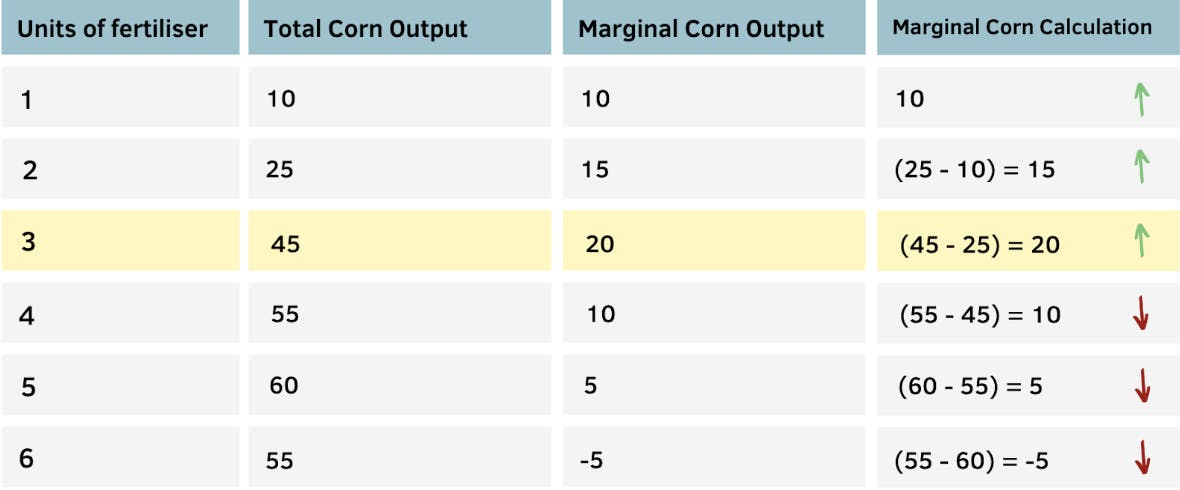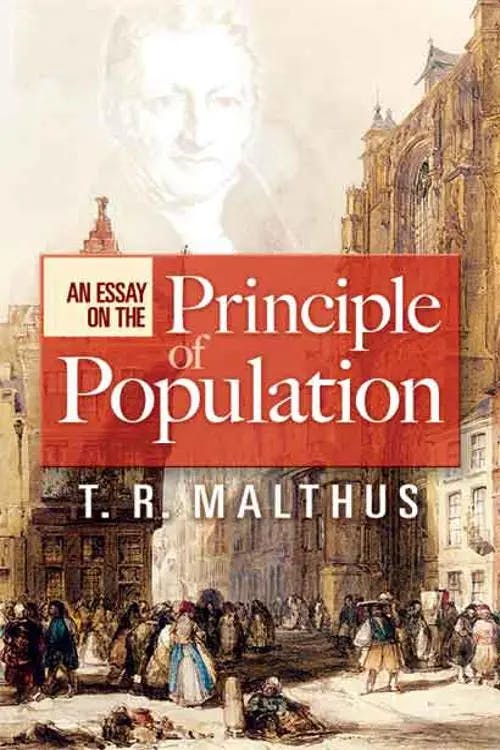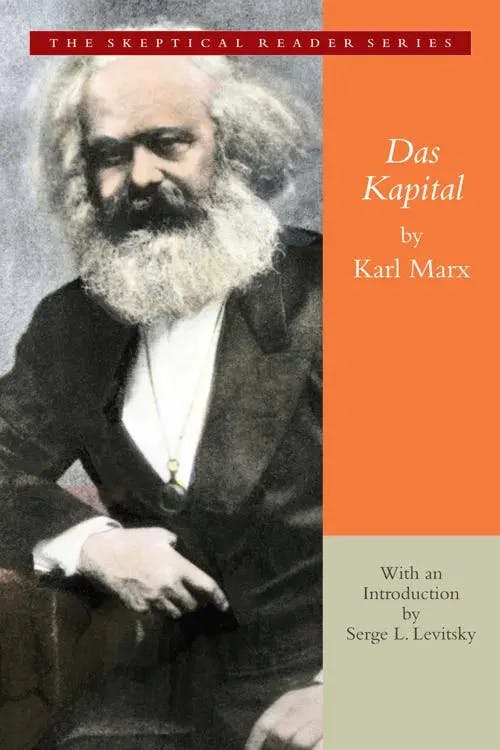What is The Law of Diminishing Returns?
MA, Management Science (University College London)
Date Published: 08.03.2023,
Last Updated: 04.10.2023
Share this article
Defining the law of diminishing returns
Like most laws in the study of Economics, the factors of production are the key actors and players in the law of diminishing returns. Factors of production include land, labour, capital and enterprise. The law of diminishing returns states that every time a new unit is added to a production process, the returns or output from that process will incrementally decrease. This phenomenon is assumed to only happen in the short-term, where all factors of production are fixed and cannot be increased, except for one.
What is the history behind the law of diminishing returns?
Born and raised in London, David Ricardo was a successful business man and broker at the London Stock Exchange who, after reading Adam Smith’s The Wealth of Nations decided to devote his career to Economics. Soon after, he became one of the most influential economists of the 18th century, and introduced the idea of the law of diminishing returns in his book On The Principles of Political Economy, and Taxation. His observation came about during the Napoleonic war, amidst food scarcity in 1800s England.
In his theory, he referred to rent as the revenue returns generated from land crops. He realised that, as farmers grew new plots of land, the revenue generated from each additional harvested plot of land would decrease. In the early development stages of the theory, diminishing returns were associated with a simultaneous decrease in the quality of the available factors of production in the harvesting of land. Indeed, David Ricardo explained that, given that land was fixed in the short-run, and the best, most fertile plots of land were being harvested first, revenues decreased for every subsequent harvested plot of land.
Rent invariably proceeds from the employment of an additional quantity of labour with a proportionally less return. (Ricardo, 2021)
Similarly, the English economist and philosopher Thomas Malthus touched base on the law of diminishing returns when developing his theory on population growth in his essay “An Essay on the Principle of Population”. He ultimately argued that as population increased, food output would incrementally decrease to the point of human starvation and famine. In Malthus’ words:
I see no way by which man can escape from the weight of this law…When acre has been added to acre till the land has been occupied, the yearly increase of food must depend upon the melioration of land already in possession. This is a fund which, from the nature of all soils, must be gradually diminishing. (1798 [2012])
T. R. Malthus
I see no way by which man can escape from the weight of this law…When acre has been added to acre till the land has been occupied, the yearly increase of food must depend upon the melioration of land already in possession. This is a fund which, from the nature of all soils, must be gradually diminishing. (1798 [2012])
Other theorists including Adam Smith, Alfred Marshall, Karl Marx, and Anne Robert Jacques Turgot further developed the law of diminishing returns, nuancing its definition. For example, Alfred Marshall, the father of economics, contributed to the law of diminishing returns in his book Principles of Economics by acknowledging that innovative improvements in the agricultural industry could limit the validity of the theory.
An increase in the capital and labour applied in the cultivation of land causes in general a less than proportionate increase in the amount of the produce raised, unless it happens to coincide with an improvement in the art of agriculture. (1890 [2021])
Some of these economists argued that the theory could be dissociated from the quality of the factors of production. Others extrapolated the applications of the theory beyond the agricultural sector. However, all economists believed that the law of diminishing returns was caused by a disruption of the production process as extra units of labour were added to a set amount of capital. They came to the shared conclusion that there is an ideal point of production, which if outdone, brings negative marginal returns.

For every past harvest season, the farmer increased the amount of fertiliser used by one unit, and recorded the total amount of corn produced in that harvest keeping all other factors constant. To apply the law of diminishing returns and find the optimal amount of fertiliser to order, the farmer should find the difference in total corn output from introducing an additional unit of fertiliser. This is known as the marginal output. The farmer should order the units of fertiliser where, for every additional unit of fertiliser, marginal output is still increasing. Note that, at this point total output may still be increasing, but marginal output (i.e., the returns from adding an additional unit of fertiliser) is decreasing.
Alfred Marshall was the first economist to discover that the law of diminishing returns could be applied to a wide range of industries and situations beyond agriculture. In recent times the essence of this law has been condensed in expressions and idioms like “more is less” or “there are too many cooks in the kitchen” . As a matter of fact, the book “The Law of Diminishing Returns” specifies that the theory may be used and applied to any process or situation where (i) one element of the process can be changed in the short-run and, (ii) the rest of factors are fixed.
For example, whilst keeping machinery and facilities static, firms may use the law of diminishing returns to calculate the number of workers that should be used to assemble a car, before the cost of producing that car exceeds the revenue generated. Students can use the law of diminishing returns to understand how many hours they should put into studying before their grades stop increasing. Families with no intention of increasing their family size may consider the law of diminishing returns when deciding the optimal house size before feeling like they are spending too much on their first house. For all these examples, there is a breaking point. That is, the point where adding more of something to the equation (whether that is workers, hours of study or square metres) will not yield any additional benefits.
What are some considerations and implications when applying the law?
The farmer, the entrepreneur, the student and the flat-hunting couple should all take into account the implications and limitations that applying the law of diminishing returns has on their respective real-life scenarios. The biggest applicability constraint is implied in the theory’s definition. In the short-run, it is close to impossible to have all factors of production but one remaining fixed. Looking at Ricardo’s example in agriculture, the number of farmers harvesting a plot of land may be purposefully altered to demonstrate the workings of the law. But what about rainfall? What if the arable land is going through a period of unforeseeable floods or droughts?
Moreover, in the third volume of his book “Das Kapital: A Critique of Political Economy” the economist, philosopher and sociologist Karl Marx identified that the effect of the law of diminishing returns was heightened in the presence of competitive pressures in an industry.
"The ensuing losses in the capitalist’s profits are offset by him, by intensifying the exploitation of labour”
“The profit rate does not fall because labour becomes less productive but rather because it becomes more productive.” (1867 [2012])
Karl Marx, Friedrich Engels
"The ensuing losses in the capitalist’s profits are offset by him, by intensifying the exploitation of labour”
“The profit rate does not fall because labour becomes less productive but rather because it becomes more productive.” (1867 [2012])
That is, in industries of high competition, marginal returns decrease more than in any other industry when introducing an additional unit of a factor of production. Therefore, firms that operate in highly competitive sectors such as the wine industry should bear this in mind when applying the law of diminishing returns.
Lastly, even though the law of diminishing returns was highly applicable in agricultural contexts prior to the industrial revolution, the way business processes are carried out now has dramatically changed since. Adam Smith himself recognised this by proposing a contrasting theory where he argued that the effects of the law of diminishing returns could be combated through task division and worker specialisation. Instead of having all farmers harvest the same plot of land, some could be in charge of the seeding, some of watering the crops, and others in charge of collecting the crops such that output is always increasing. This modus-operandi best resembles the way many companies go about business in the 21st century.
Closing thoughts
Overall, the law of diminishing returns is an extremely useful principle to understand why more is not always better. The historical legacy and involvement of different economists in the shaping of the law comes to show that the innate need of optimising productive efforts started a long time ago, and is not only a trend amongst newer hyper-productive generations.
Further Resources & Reading on Perlego
To read about more real-life examples on how the Law of Diminishing returns applies to our lives, Afterburn: Society Beyond Fossil Fuels by Richard Heinberg.
To read about more real-life examples on when more is less, The Paradox of Choice: Why More is Less by Barry Schwartz
To read more about Karl Marx’s theories and views on returns, An Introduction to the three volumes of Karl Marx’s Capital by Michael Heinrich
To read more about Malthus’ theory of population, Figuring the Population Bomb by Carole McCan
To read more about Adam Smith’s life and findings, Adam Smith: A Pioneer of Modern Economics by 50 Minutes.
Bibliography
Smith, A. (2010). The Wealth of Nations. 1st edition. Wiley. Available at: https://www.perlego.com/book/1006961/the-wealth-of-nations-the-economics-classic-a-selected-edition-for-the-contemporary-reader-pdf
Ricardo, D. (2021). On The Principles of Political Economy, and Taxation. Illustrated. Strelbytskyy Multimedia Publishing. Available at: https://www.perlego.com/book/3042265/on-the-principles-of-political-economy-and-taxation-illustrated-pdf
Malthus, T. (2012). An Essay on the Principle of Population. Dover Publications. Available at: https://www.perlego.com/book/110207/an-essay-on-the-principle-of-population-pdf
Marshall, A. (2021). Principles of Economics. Illustrated. Strelbytskyy Multimedia Publishing. Available at: https://www.perlego.com/book/3041868/principles-of-economics-illustrated-pdf
50minutes. (2016). Law of Diminishing Returns. 50Minutes.com. Available at: https://www.perlego.com/book/9311/law-of-diminishing-returns-the-key-to-understanding-the-fundamentals-of-productivity-pdf
Marx, K. (2012). Das Kapital. Gateway Editions. Available at: https://www.perlego.com/book/784600/das-kapital-a-critique-of-political-economy-pdf
Useful External Resources
https://faculty.econ.ucdavis.edu/faculty/gclark/Farewell%20to%20Alms/FTA-chapter2.pdf
MA, Management Science (University College London)
Inés Luque has a Masters degree in Management Science from University College London. During high school, she developed a strong interest in Economics, leading her to win the national Economics prize in her country of nationality, Spain. Her expertise is in the areas of microeconomics, game theory and design of incentives. Inés is passionate about the publishing industry and is currently working in the consulting department of the Financial Times in London.


